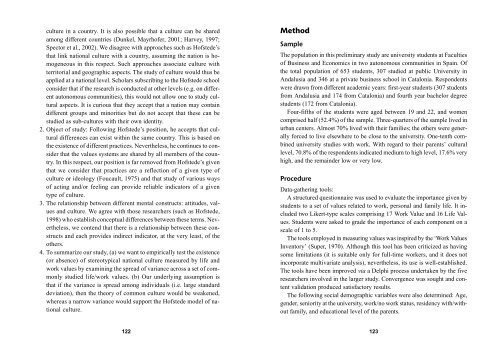Life/work values - Spirit Consulting Group SL
Life/work values - Spirit Consulting Group SL
Life/work values - Spirit Consulting Group SL
Create successful ePaper yourself
Turn your PDF publications into a flip-book with our unique Google optimized e-Paper software.
According to Schwartz (1999), <strong>values</strong> represent the concepts of what is<br />
really desirable that guides social actors in their selection of behaviors, assess<br />
other people and explain people responses in general. One of the central<br />
aspects that defines <strong>values</strong> is its preferential character, in that a value is<br />
primarily an activity or preferential process of singling out a given behavior.<br />
The preferential character of <strong>values</strong> also acts simultaneously in setting up<br />
an order or a hierarchical structure of respective <strong>values</strong>. Secondly, given<br />
that espoused <strong>values</strong> represent a sort of preference, it is obvious that, implicitly<br />
or explicitly, some kind of order is established. The totality of this<br />
order represents the value matrix/system of the person.<br />
On the basis of this discussion, a number of questions can be raised with<br />
reference to the distinct <strong>values</strong> in each culture, organization or job setting.<br />
Are they universal or are they unique? Is cultural variation manifested only<br />
in its form or also in its content? Other relevant aspects seem to be the<br />
relationships between the value system and the predisposition to behave in<br />
distinct cultures. All the above topics enable researchers to render operational<br />
the concept of <strong>values</strong>.<br />
Thus, <strong>values</strong> guide daily actions, bind groups, help resolve conflicts and<br />
stimulate development. All cultures contain more-or-less explicit value systems<br />
(Schein, 1985; Dunkel, Mayrhofer, 2001; García, Dolan, 1997) that<br />
determine behavior.<br />
Work <strong>values</strong>, according to some scholars, represent a subset of our general<br />
<strong>values</strong> (Elizur, 1991; Elizur, Sagie, 1999). These <strong>values</strong> have been studied<br />
from different conceptual angles. They have been defined as vocational orientation<br />
(Pryor, 1981; Super, 1995); predisposition to behave in a <strong>work</strong><br />
setting (England, 1967; Ravlin, Meglino, 1989); and importance in terms of<br />
<strong>work</strong> accomplishments (Elizur, 1984; Levy, Guttman, 1976; MOW studies,<br />
1987). These definitions represent a refinement of necessities that emerge<br />
through socialization (Lofquist, Dawis, 1971; Super, 1995), or as ideologies<br />
or philosophies that enable us to understand individual behavior at<br />
<strong>work</strong> (England, 1967).<br />
Other scholars classify <strong>values</strong> into three types according to their nature:<br />
instrumental, affective and cognitive (Zarhi, Elizur, 1996; Elizur,<br />
Koslowsky, 1996). In organizational behavior, instrumental <strong>values</strong> include<br />
relationship with others, such as colleagues and superiors; affective <strong>values</strong><br />
are responsibility, influence, feedback, the importance of <strong>work</strong>, etc;<br />
and cognitive ones include status and contribution to society. This initial<br />
classification of <strong>values</strong> has been termed ‘Work Outcomes’ (Elizur, 1984).<br />
The same author also described a second classification based on system<br />
contingencies and the behaviour of individuals with regard to an organization’s<br />
need to pull things together to <strong>work</strong> effectively and to motivate its<br />
staff. Job security is one of the <strong>work</strong> <strong>values</strong> that is currently given the<br />
greatest importance in the present system of <strong>values</strong>. The results obtained in<br />
different countries corroborate these assertion (Elizur, 1991; Zarhi, Elizur,<br />
1996; Dolan et al., 2002).<br />
The perceived impact of organizational culture on individual behaviour has<br />
been articulated for many years. Hofstede likened culture to a collective<br />
programming of the minds of one group that differentiates them from other<br />
groups; he believes this programming derives from one’s social culture.<br />
(Hofstede, 1991). However, he considers that national culture is differentiated<br />
from organizational culture in that the former is based more on <strong>values</strong><br />
and socialization patterns occur in the family. By contrast, the latter is based<br />
more on practices and <strong>work</strong> is the sphere in which socialization takes place.<br />
The impact of culture on behaviour has been postulated for many years and<br />
its impact continues to be demonstrated. For example, 103 human resource<br />
professionals at major US-based organizations were asked to identify the<br />
most important factors influencing the management development programs<br />
in their organizations (The Conference Board, 2001). Four factors were<br />
mentioned by over two-thirds of the respondents: The CEO’s vision and<br />
<strong>values</strong>, the organization’s strategic plan, the operating needs of the line<br />
managers, and the organization’s culture. Thus, the potential impact of individual’s<br />
<strong>values</strong> on culture is a topic that is receiving increased interest as<br />
change, and change management, have emerged as important activities of<br />
the new human resource management roles (Schuler, Dolan, Jackson, 2001).<br />
The effects of socio-demographic variables such as age, education, gender,<br />
and seniority upon this relationship have also been reported. The most<br />
often studied of these variables is gender. According to the literature, men<br />
tend place greater value on issues concerning socio-economic status, prestige<br />
and power (Dolan et al., 2002; Elizur, Sagie, 1994). By contrast, women<br />
are more concerned with socio-affective issues such as <strong>work</strong> climate, safety<br />
at <strong>work</strong>, and relationships with their colleagues. However, some authors<br />
(Elizur, Koslowsky, 1996; Koslowsky, Staskevsky, 2000) have emphasized<br />
that socio-demographic issues (such as gender) should not be divorced from<br />
the cultural characteristics of a given society or context.<br />
118<br />
119



